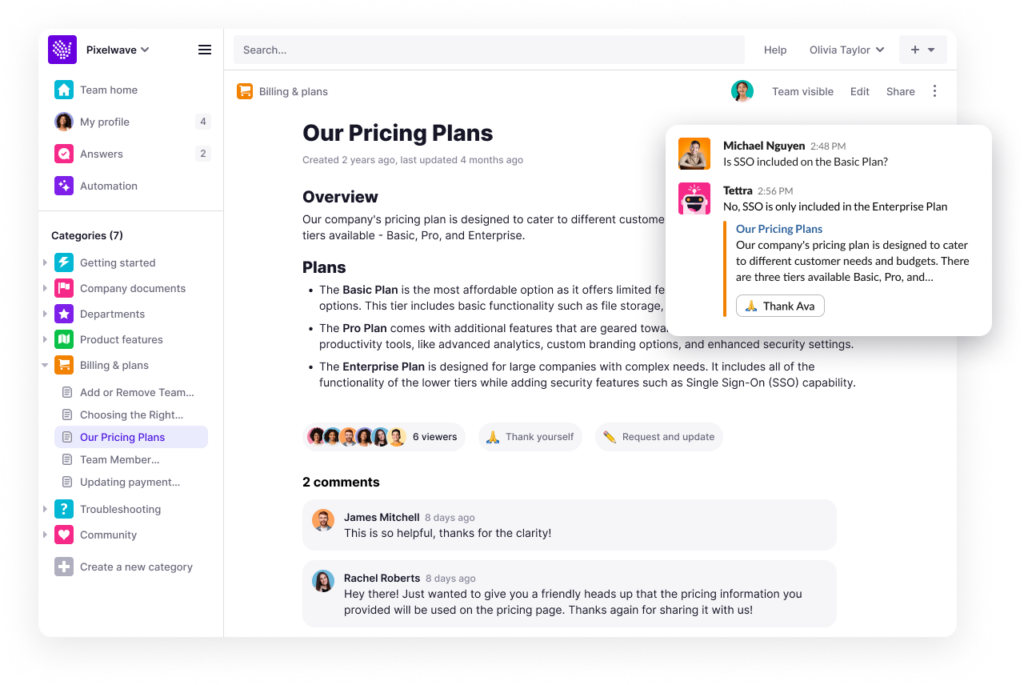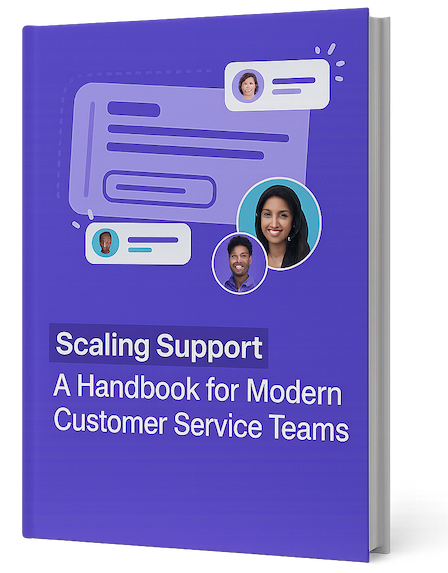This is an excerpt from “Scaling Support Teams,” an ebook from Supportman and Tettra.
Delivering great customer service at scale requires a system of flexible and interconnected parts that, taken together, are capable of consistently helping and delighting customers.
Every support team relies on a combination of tools to deliver help to customers, and those tools are becoming increasingly capable in the age of generative AI.
But the core of that system — the beating heart of it all — are the people that make up your customer support team, whether it’s a small team of three or a sizable team of 300.
Those humans are an indispensable part of everything you do, and you’ll never be able to scale your customer service if you can’t first lay a solid foundation of trusting relationships, change management, and sustainable working practices among your team.
Building Trust
Everyone knows customer service is often a stressful job. It’s fast-paced, always-changing, and regularly involves helping frustrated individuals with problems you didn’t personally cause.
That’s why trust is so important among customer support teams. When you’re working in a high-stress environment, it’s crucial to know that your peers (and bosses) have your back. Similarly, it’s critical that you’re someone who can be relied upon.
But what does trust within a team actually mean? It can feel vague or hazy to say, “Trust one another.” People are complicated, so how can you foster trust between members of a growing team?
The key is to recognize that trust within a team isn’t merely about believing in each other’s abilities; it’s about creating an environment where transparency, accountability, and mutual support are at the forefront.
And for support, service, and operations leaders, establishing trust is crucial, especially during periods of change and growth.
How do you do this well?
Building trust doesn’t happen overnight or automatically. It requires building foundational habits and cultural norms into the way your team operates, and following through on those values consistently.
In customer support, three factors are particularly important to getting this right:
- Be transparent. Whenever possible, pull back the curtain and be transparent — about the ‘why’ behind decisions, about how you’re feeling, about obstacles to success and your hopes for the future.
- Follow through on commitments. It’s cliché, but actions really do speak a thousand words. When your team sees you following through on your promises, it signals they can count on you in the future.
- Be accountable for outcomes. Accountability for outcomes means you’re taking responsibility to make something happen, even if you encounter unexpected obstacles along the way. If (or when) you can’t achieve a specific outcome, it also means taking ownership and not making excuses.
Here’s an example of all three of these in the real-world:
Say your CSAT scores are consistently low, and they need to improve or the likelihood of customers churning will go up.
Being transparent would mean sharing not just the score itself, but the context around why scores are low, why they need to improve, and why your team members should care about increasing CSAT scores.
If, in your research, you find that one big reason CSAT scores are low is because your scheduling is inadequate and customers are frequently stuck waiting on hold for a chat agent, you’d then make a commitment to improve your scheduling and decrease wait time within a certain time period, then working toward that goal
Lastly, being accountable for outcomes means that you’d define the success of your project up front — say, reducing chat wait times by two minutes this quarter — and flagging risks to achieving that outcome. Whether you hit the goal or not, you’d work to overcome obstacles and share learnings along the way.
It’s far easier said than done, but the only way to build meaningful trust is to embed habits like these into your team’s operating environment.

Measuring Trust with Your Team
Implementing qualitative and quantitative measures, such as employee satisfaction surveys and leadership satisfaction surveys, can provide insights into the level of trust within the team. These are often the best ‘formal’ metric for measuring the level of trust you’ve developed.
But there are also other, less-tangible ways to measure trust, like gauging the speed of adopting a new process and the frequency and quality of feedback your team provides you with.
If your team is comfortable sharing uncomfortable feedback, risky ideas, and admitting mistakes, you’ve achieved at least some measure of psychological safety.
Earning Respect
Respect is closely related to trust. It’s earned through taking action that demonstrates your commitment to the team’s success and well-being.
That can take many different shapes, from challenging a decision made by your executive team to choosing to shut down the phone lines for half a day to focus on team building and training exercises.
Recognizing Inequity and Power Dynamics
Every social group in the world has inherent power dynamics, and a customer service team is no different. It’s worth calling out that one way effective leaders serve their team — earning respect and building trust — is by recognizing those power dynamics and finding ways to ensure every team member feels valued and heard.
From celebrating diversity to conducting regular one-on-ones to developing transparent performance and promotion criteria, there are many ways you can create a more equitable environment for your team to work in.
Delivering Results and Showing Respect
Respect is also usually tied to competency. It’s hard to respect someone who seems totally inept at their job, isn’t it?
That doesn’t mean that, as the leader of a customer service team, you should be carrying a weekly ticket quota or should have the same level of technical proficiency as your senior team members. It does mean that if they’re going to respect you, your team needs to see you’re competent at your job — which often involves advocating for them, supporting their needs, and helping them achieve goals they couldn’t achieve individually.
Encouraging Curiosity and Resourcefulness
Creating a culture where curiosity is encouraged and resourcefulness is rewarded helps in building a resilient and adaptable team. As you scale your customer service, you’ll face all kinds of new problems and unexpected challenges. You want team members who are willing and able to take creative risks and attempt novel approaches.
As a leader, you should try to foster an environment where asking questions and seeking better ways to solve problems are strengths to be celebrated, not threats to be silenced.

Managing Responses to Change in a Customer Support Team
There are many different responses to change, ranging from anxiety and excitement to resistance and indifference. Since change is always happening in customer support, understanding responses to change and approaching change thoughtfully also helps to build additional trust and earn respect from your team.
Anxiety around Change
Anxiety is a common response to change, particularly when changes are significant or sudden. To manage change-related anxiety effectively, it’s essential to communicate clearly and consistently — even when you don’t have much time to prepare.
A good way to improve at this is to practice preemptively addressing potential questions and concerns, based on what you know of your team and your company. How do you think Tom will react? What is Imani likely to feel?
Anticipating how change will land with your team enables you to tailor your messaging, providing appropriately detailed explanations of the changes, and ensuring you leave open channels for feedback.
Ensuring that your team feels heard and understood can massively reduce anxiety and build confidence in the overall change process.
Excitement about Change
While some team members may feel anxious, others might be excited about changes. When harnessed well, this excitement can be a powerful asset and can help create buy-in with the rest of the team.
When a team member is excited about change, try to link the benefits of the change directly to that team members’ needs and goals. This will help reinforce their initial enthusiasm, and will increase the odds that they’ll help champion the positive aspects of the change to other members of the team.
Resistance to Change
Resistance is another common reaction to change, stemming from fear of the unknown, discomfort with new processes, or even just from satisfaction with the status quo.
When working with team members who are resistant to change, it’s important to engage with them. Ask questions to understand their concerns. Find ways to involve them directly in the change process. Use their feedback to refine your approach to change.
We care about things we help create, and anytime you can find ways to get a resisting team member to shift from dragging their feet to helping create the change, the result will be less resistance and more acceptance.
Indifference to Change
When a team member is indifferent towards upcoming change, it’s often a symptom of a deeper problem. For instance, indifference might signal a lack of overall engagement or a lack of investment in the outcomes of the change.
Sometimes, indifference to change can even be a sign that a customer support agent is checked out and will soon be leaving for another role.
Tackling indifference to change isn’t quite as straightforward given these underlying issues. Often, it’s helpful to use tools like employee engagement surveys to understand how team members feel about their role, their career, and their bosses.
The more clarity you can get around what motivates your team members, the more you can then tap into that motivation during the change process.
Sustainable Workloads and Processes
The customer support space is sadly infamous for unsustainable workloads, high turnover, and burnout.
As your team scales, the complexity and volume of work can increase exponentially. Trying to navigate this while also dealing with high burnout or low job satisfaction isn’t just about operational efficiency — it’s about the health of your team and your organization.
Protecting your team’s mental and physical health should be motivation enough for developing sustainable workloads and efficient processes, but also realize that it’s impossible to deliver high-quality customer service if your whole team is disengaged or is constantly turning over .
Recognizing Unsustainable Practices
Unsustainable work practices often start subtly, but can quickly become the norm for any team. Despite your best intentions, they can become entrenched in your team’s culture and then become difficult to change.
Common signs of unsustainable practices in support teams include:
- Consistently high occupancy rates : Occupancy measures the percentage of time your team spends actively helping customers versus the time they’re available to help customers (e.g. if they’re on the phone for three hours in a five hour shift, that’s an occupancy of 60%).
When occupancy rates consistently exceed 90%, your team is at risk of burnout and something needs to change.
- Increasing turnover rates. When you see team members begin to leave at a higher pace, it’s often a signal of unsustainable work practices.
Decreasing employee engagement often precedes increased turnover.
- Reduced headcount and budget. When you expect the same or increased output from a team while cutting back on resources and headcount — without investing in tools or other ways of unlocking efficiencies — you’re in trouble.
- Inconsistent workloads. Every support team will include higher performers and lower performers. But when you have a small subset of agents consistently doing far more than their fair share of the work, it’s often a sign of mismanagement and isn’t sustainable for the long haul.
Customer support volume often ebbs and flows. Seasonality or outages can bring huge increases in volume and can force teams into unsustainable situations.
The duration is a key factor to consider when evaluating your team’s workload.

“I remember in a past role, during an election year, our marketing team decided to pull our advertising from a particular news segment because they felt it was getting too ‘out there’,” says Larry Barker, CX Operations Manager at Teamshares. “No one gave us a heads up or expected any backlash, but it led to our normal volume of several hundred tickets per day spiking to tens of thousands. Fortunately, it peaked within a week, then tapered off in the weeks that followed.”
Any solid support team can step up to the challenge and shoulder a ridiculous workload for the short-term.
In fact, sometimes those wild moments can bring a team together and create more unity and solidarity than you’ve ever had before.
But if it drags on too long, eventually it will erode trust and respect, totally undermining any work you’ve done to build up those two critical items. Letting unsustainable practices become the new normal signals to employees that their well-being and satisfaction aren’t priorities for the organization.
One approach that can really help here is to build great working relationships with other departments across your organization.
While an increase in volume isn’t always due to a poor decision or a mistake by another team, it’s unfortunately not uncommon for other departments to underestimate (or forget) the impact their decisions have on the support team. Useful tactics include:
1. Hold post-mortems after a season where your support team faced a huge spike in volume.
Pulling together stakeholders to understand what went wrong is a great chance to educate the leaders of other teams on the trickle down effect their decisions have, particularly on support and on your customers.
You can then take these learning to share with your team, encouraging them that you’re proactively working to make things better.
2. Set up shadow sessions or “a day in the life of support” demos.
Most engineers, marketers, and product managers have never worked in support. Building mechanisms to help them understand how your support team operates and to build relationships with support agents creates more empathy and encourages them to be considerate in their decision-making.
An overworked and stressed support team is far less likely to interact with customers in a consistently positive manner, so any time you have an opportunity to get ahead of potential volume spikes and to plan for change, it’s a worthwhile time investment.
Building Sustainable Workloads
To counteract these unsustainable practices, customer service leaders must focus on creating and maintaining workloads and processes that support the team’s long-term success and well-being:
- Set ambitious, yet realistic metrics. Choose goals and metrics that challenge your team to do their best work, but also acknowledge their need for breaks, varied work, and personal growth.
Build shrinkage into your workforce management process to give your team time to tackle other tasks and join training sessions. Your metrics have a huge impact on your staffing forecast, so do your best to dial in on what a sustainable workload looks like.
- Plan ahead. When your ticket volume is likely to increase — due to things like seasonality or a major marketing push — you need to get upstream. Recruiting and training new hires can take weeks (or months, depending on your product), so plan ahead and start recruiting early when you think it will be necessary.
- Create a regular review cycle. Support teams aren’t static. They’re always changing, and improvements in technology are opening up new ways to support customers. Build a quarterly or biannual review into your calendar, and use that time to review metrics, performance, tool improvements, and customer feedback.
The way you approach staffing, workload management, and scheduling will always need to match the stage of your company’s growth (and your current business objectives).
For example, when a SaaS company approaches the 1000 customer threshold, it’s very important to understand the ticket rate per customer per month and what the primary contact reasons are.
Instead of continuing to hire team members at the same pace to handle every type of customer ticket, you might decide to invest more time in self-service options for customers to eliminate straightforward tickets that produce significant volume.
This could lead to creating a new, smaller tier of support that can handle more complex tickets and help produce and maintain self-service content.
Implementing Sustainable Practices
All of the above will help in building a more sustainable workload for your team, but when it comes to operating sustainably, customer service leaders should also consider these best practices:
- All tickets aren’t created equal. Solving highly technical problems takes far more time and effort than handling simple issues. Realities like these need to be baked into your metrics, so that you can accurately understand your team’s current performance and so you can create the best possible plan for your team’s future.
- Fight for a place at the table. It’s very easy for support teams to have a victim mentality and feel like they can’t affect change. Much of this is because they’ve been conditioned to think that way, but that vibe is changing as more companies recognize customer experience as a differentiator. As a CX leader, advocate for your team’s needs and find ways to quantify the impact of great support — even if it feels like an uphill battle.
- Lean heavily on continuous process improvement. Aim to make things better, each and every day. While finding ways to save ten seconds on a ticket might not feel like a big deal, if you’re handling thousands of tickets each month those seconds quickly add up.
AI-powered tools are becoming more capable every day, and there are probably dozens of ways you can refine processes to improve your team’s quality of life.
- Be transparent about resources. When workloads are stressful, be upfront with your team about resource constraints and how you’ve allocated the resources you have — especially if you’re asking them to do more with less. While it may not make the work easier, helping your team understand the business context and how decisions are made can take the sting out of those decisions, helping them to not feel undervalued or exploited.
Building sustainable workloads and practices in a customer service team is a job that never ends, but it’s critical to building a capable support team that can scale efficiently and effectively.
Takeaways for your support team:
- Measuring trust can be both qualitative (surveys) and observational (feedback quality).
- Respect is earned through competent leadership and addressing power dynamics within the team.
- Encourage curiosity and resourcefulness to foster a resilient and adaptable team.
- Managing responses to change thoughtfully helps build further trust and respect.
What next?
- If you’re using Intercom, try Supportman to instantly receive your CSAT scores in Slack
- Use Tettra to find answers to common questions fast


